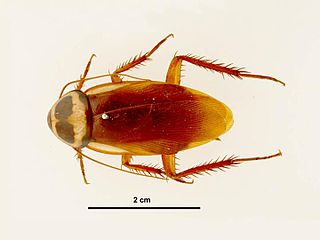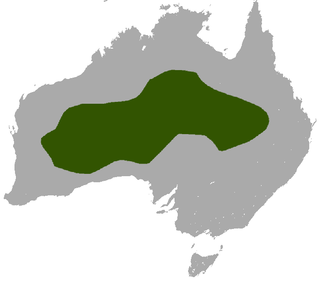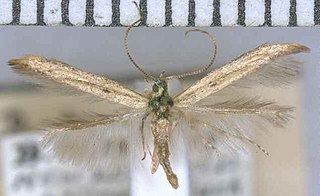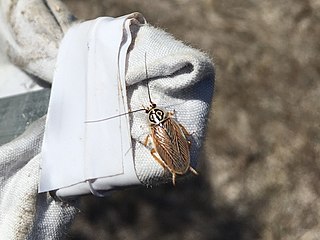
Ficus macrophylla, commonly known as the Moreton Bay fig or Australian banyan, is a large evergreen banyan tree of the Mulberry Family (Moraceae) native to eastern Australia, from the Wide Bay–Burnett region in the north to the Illawarra in New South Wales, as well as Lord Howe Island where the subspecies F. m. columnaris is a banyan form covering 2.5 acres or more of ground. Its common name is derived from Moreton Bay in Queensland, Australia. It is best known for its imposing buttress roots.

A number of introduced species, some of which have become invasive species, have been added to New Zealand's native flora and fauna. Both deliberate and accidental introductions have been made from the time of the first human settlement, with several waves of Polynesian people at some time before the year 1300, followed by Europeans after 1769.

Landcare Research is a New Zealand Crown Research Institute whose focus of research is the environment, biodiversity, and sustainability.

Ectobiidae is a family of the order Blattodea (cockroaches). This family contains many of the smaller common household pest cockroaches, among others. They are sometimes called wood cockroaches. A few notable species include:

The Australian cockroach is a common species of tropical cockroach, with a length of 23–35 mm (0.91–1.38 in). It is brown overall, with the tegmina having a conspicuous lateral pale stripe or margin, and the pronotum with a sharply contrasting pale or yellow margin. It is very similar in appearance to the American cockroach and may be easily mistaken for it. It is, however, slightly smaller than the American cockroach, and has a yellow margin on the thorax and yellow streaks at its sides near the wing base.

The Wongai ningaui is a tiny carnivorous marsupial native to the arid open grasslands of inland Australia. Their diet is mainly small insects, and occasionally larger prey such as spiders, grasshoppers and cockroaches, which they forage for at the ground and in clumps of spinifex. They have long and untidy fur, grey or gingery brown with longer black hairs, small ears, a narrow muzzle, and possess a partially prehensile tail and feet that allow them to climb. The population occurs sparsely across a wide area and common in favourable habitat, especially in years of good rainfall. Ningaui ridei was first described in 1975, one of two species of a new genus discovered amongst the poorly known mammals of the western regions of Australia.

The spade-toothed whale is the rarest species of beaked whale. Most specimens found have been in the South Pacific, mostly in New Zealand, but they have also been found in Chile. It is a species of which there is very little known.

Acanthopagrus australis, the yellowfin bream, also known as sea bream, surf bream, silver bream or eastern black bream, is a species of marine and freshwater fish of the porgy family, Sparidae. It is a deep-bodied fish, occasionally confused with Acanthopagrus butcheri, but is generally distinguished by its yellowish ventral and anal fins. It is a popular target for recreational fishermen due to its capacity to fight well above its weight coupled with its table quality.

Batrachedra arenosella, the armoured scale eating caterpillar or the coconut moth, is a species of moth of the family Batrachedridae. It was first described by Francis Walker using specimens collected in Auckland, New Zealand. It has been hypothesised that the New Zealand moth may contain two distinct species. As well as the moth species in New Zealand, this name has been applied, perhaps incorrectly, to moths found in India, Indonesia, the Malay Peninsula, and Réunion, as well as in Australia, from the Northern Territory and northern Queensland to New South Wales and South Australia.

New Zealand has a number of rare and endangered species and there have been cases of wildlife smuggling. New Zealand is a signatory to CITES which was set up to ensure that international trade in specimens of wild animals and plants does not threaten their survival. CITES is administered by the Department of Conservation. Prosecutions from smuggling wildlife can be made under the Trade in Endangered Species Act 1989.
Biosecurity in New Zealand guards against threats to agriculture and biodiversity, with strict border control measures being taken to prevent unwanted organisms from entering the country. New Zealand is an island nation that is geographically isolated from any other significant landmass. The species that are present evolved in the absence of organisms from elsewhere and display a high degree of endemism. Notable is the lack of land-based mammals, except for two species of bat. Indigenous species are at risk from population decline or extinction if any invasive species are introduced. The Ministry for Primary Industries (MPI) is the government department in charge of overseeing New Zealand's biosecurity. The Biosecurity Act 1993, which was a world first for biosecurity control, was passed to "restate and reform the law relating to the exclusion, eradication, and effective management of pests and unwanted organisms".

The Pseudophyllodromiinae are a subfamily of cockroaches, in the family Ectobiidae, with a world-wide distribution.

Mallada basalis is a species of green lacewing in the family Chrysopidae, first described by Francis Walker in 1853. No subspecies are listed in the Catalog of Life. The species was detected on mainland New Zealand in the 2010s.

The Plant Pathology Herbarium and Insect Collection is a Queensland Government scientific collection based in Queensland, Australia. Based at the Department of Agriculture and Fisheries, the collection holds specimens of known fungal pathogens of plants grown in Queensland, as well as insect pests that occur in the state. In 1966 the herbarium was given the abbreviation BRIP. This abbreviation has official status in that it was the first listed in Index Herbarium. The abbreviation is not an acronym where each letter represents a word, but rather derived from the words 'Brisbane' and 'Pathology'.

Balta is a genus of cockroaches in the sub family Pseudophyllodromiinae. Found in Asia, Africa, Australia and Oceania. The genus was created in 1893 by Johann Tepper.

Balta hebardi is a species of cockroach, found in Western Australia. The specific epithet honors the entomologist Morgan Hebard.

Crassitoniella carinata is a species of marine gastropod mollusc in the family Eatoniellidae. It was first described by Winston Ponder in 1965, and it is the type species for the genus Crassitoniella. It is endemic to the waters of New Zealand.

Balta yorkensis is a species of cockroach in the family Ectobiidae.

Ellipsidion is a genus of cockroach in the family Ectobiidae. According to the Cockroach Species File, it contains eighteen species:

Methana marginalis, also known as the common methana and the bush cockroach, is a species of cockroach native to the Queensland coast of Australia. The species was first described as Periplaneta marginalis by Henri Louis Frédéric de Saussure in 1864. The species was introduced to Norfolk Island in the mid-to-late 20th century, first seen in New Zealand in the 2020s, and in the 21st century has increasingly been seen in the southeastern Australia.






















